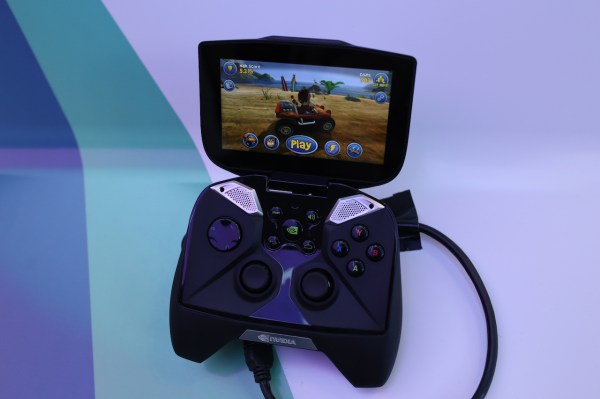NVIDIA brought its new Shield handheld gaming system to Google I/O this year and showed off a near-production device. The Shield made its debut at CES this year, surprising most since it’s a consumer handheld device from a company that generally makes internal components. But it has some neat tricks up its sleeve, including a Tegra 4 chipset, 2GB of RAM, a 5-inch 720p display and 16GB of internal storage.
The Shield units available at I/O this week were all running Android and showing off Android games with hardware controller support, and none were demoing the PC game streaming that NVIDIA said would be coming to Shield as a beta when it comes to retail in June.
My experience with the NVIDIA was limited to just a few games, including the Epic Citadel demo that always gets trotted out to demonstrate amazing graphics capabilities on mobile devices. There were also a couple of playable cart racers in action, and all of the above performed well and really showed that the hardware is capable of rendering high-quality video smoothly and without any apparent effort. For a device that’s essentially a smartphone without the actual phone powers, but with more physical buttons for $349, that’s an important achievement to be able to claim.[gallery columns="4" ids="818663,818664,818665,818666,818667,818668,818669,818670,818671,818672,818673"]
Shield does its Android job well, and the hardware feels great to these gamers’ hands. Buttons are slightly clicky and the ergonomics are solid, and the thing doesn’t take up too much more space than an Xbox controller when the screen is folded down and it’s in travel mode. There’s mini-HDMI, which was outputting gameplay to a small HD television, and a micro-USB slot for charging. The onboard screen boasts “retinal” quality 294 PPI pixel density, which means video and games look silky smooth.
Maybe the best part is that NVIDIA has gone for a pretty near stock Android Jelly Bean experience, which a rep from the company told me was a conscious choice they made after first trying a more involved widget overlay that ended up making for a much less pleasant experience. Navigating the stock Android with hardware controls (you can also always use the touchscreen) is also surprisingly intuitive.
All that said, this is a strange device with a market that’s probably going to be pretty niche. Really, it almost seems like a reference device designed to show off the power of Tegra, but NVIDIA is actually shipping the thing, so those of us like me who actually have a hankering for this kind of hardware will really be able to buy it even if it doesn’t become a runaway success.

